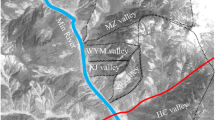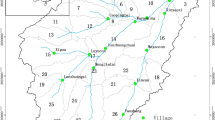Abstract
Evaluating the flood discharge and deposition process of a debris flow is important for risk assessment, management, and design of possible supporting works for geo-hazard mitigation. The movement and deposition process of a typical debris flow gully in southern Gansu province, China, was simulated using the Soil Conservation Service-curve number (SCS-CN) approach and a two-dimensional finite model (FLO-2D PRO model) coupled with geographic information systems. Runoff volumes and depths were obtained by the use of the SCS-CN model using different precipitations and different intervals. The deposition, velocity, impact force, and influence zone of the debris flow were simulated with the FLO-2D PRO model based on the results of the SCS-CN method. Simulation results for a storm that occurred on 12 October 2010 suggest a maximum flow velocity of 23.1 m/s, a maximum deposition depth of 27.9 m, and a hazard zone of about 0.414 km2. These results were consistent with measured results from the documented debris flow. Verification demonstrated that model results could be used to help predict disaster-causing debris flows, thus helping to protect the lives, property, and economy of the local population.








Similar content being viewed by others
References
Aleotti P, Polloni G (2003) Two-dimensional model of the 1998 Sarno debris flows (Italy): preliminary results. In: Rickenmann D, Chen CL (eds) Third international conference on debris-flow hazards mitigation: mechanics, prediction and assessment. Mill Press, Rotterdam, pp 553–563
Azoozr H, Arshad MA (1996) Soil infiltration and hydraulic conductivity under long-term no-tillage and conventional tillage systems. Can J Soil Sci 76:143–152
Bai SB, Wang J, Zhang FY, Pozdnoukhov A, Kanevski M (2008) Prediction of landslide susceptibility using logistic regression: a case study in Bailongjiang River Basin, China. In: Ma J, Yin Y, Yu J, Zhou SG (eds) Proceedings of the fifth international conference on fuzzy systems and knowledge discovery (FSKD 2008), vol 4. IEEE, Los Alamitos, pp 647–651
Bertolo P, Wieczorek GF (2005) Calibration of numerical models for small debris flows in Yosemite Valley, California, USA. Nat Hazards Earth Syst Sci 5:993–1001
Bhuyan SJ, Mankin KR, Koelliker JK (2003) Watershed-scale AMC selection for hydrologic modeling. Trans ASABE 46(2):303–310
Chen SC, Wu CY, Huang BT (2010) The efficiency of a risk reduction program for debris-flow disasters—a case study of the Songhe community in Taiwan. Nat Hazards Earth Syst Sci 10(7):1591–1603
Dai FC, Lee CF (2001) Frequency–volume relation and prediction of rainfall-induced landslides. Eng Geol 59:253–266
Doglioni A, Simeone V (2014) Geomorphometric analysis based on discrete wavelet transform. Environ Earth Sci 71(7):3095–3108
Dokuchaev VV (2000) Russia soil classification. Soil Sci Inst Russ Acad Agric Sci 20:1–232
Dongquan Z, Jining C, Haozheng W, Qingyuan T, Shangbing C, Zheng S (2009) GIS-based urban rainfall–runoff modeling using an automatic catchment-discretization approach: a case study in Macau. Environ Earth Sci 59(2):465–472
Garcia R, López JL, Noya M, Bello ME, Bello MT, Gonzalez N, Paredes G, Vivas MI, O’Brien JS (2003) Hazard mapping for debris flow events in the alluvial fans of northern Venezuela. In: Rickenmann D, Chen CL (eds) Third international conference on debris-flow hazards mitigation: mechanics, prediction and assessment. Mill Press, Rotterdam, pp 10–12
Gupta P, Punalekar S, Panigrahy S, Sonakia A, Parihar J (2012) Runoff modeling in an agro-forested watershed using remote sensing and GIS. J Hydrol Eng 17(11):1255–1267
Hadadin N (2013) Evaluation of several techniques for estimating stormwater runoff in arid watersheds. Environ Earth Sci 69(5):1773–1782
Hsu SM, Chiou LB, Lin GF, Chao CH, Wen HY, Ku CY (2010) Applications of simulation technique on debris-flow hazard zone delineation: a case study in Hualien County, Taiwan. Nat Hazards Earth Syst Sci 10:535–545
Jain M, Durbude D, Mishra S (2012) Improved CN-based long-term hydrologic simulation model. J Hydrol Eng 17(11):1204–1220
Jena S, Tiwari K, Pandey A, Mishra S (2012) RS and geographical information system-based evaluation of distributed and composite curve number techniques. J Hydrol Eng 17(11):1278–1286
Mishra SK, Singh VP (2003) Soil Conservation Service curve number (SCS-CN) methodology. Kluwer Academic Publishers, Dordrecht, pp 43–47
Mishra SK, Pandey A, Singh VP (2012) Special issue on Soil Conservation Service curve number (SCS-CN) methodology. J Hydrol Eng 17(11):1157
Nagarajan N, Poongothai S (2012) Spatial mapping of runoff from a watershed using SCS-CN method with remote sensing and GIS. J Hydrol Eng 17(11):1268–1277
National Soil Survey Office (NSSO) (1998) Soil of China. China Agriculture Press, Beijing, pp 20–29
O’Brien JS (2006) FLO-2D user’s manual, version 2006.01. FLO-2D Software, Inc., Nutrioso
O’Brien JS, Julien PJ, Fullerton WT (1993) Two-dimensional water flood and mudflow simulation. J Hydraul Eng 119(2):244–261
Peng SH, Lu SC (2012) FLO-2D simulation of mudflow caused by large landslide due to extremely heavy rainfall in southeastern Taiwan during Typhoon Morakot. J Mt Sci 10(2):207–218
Rawls WJ, Ahuja LR, Brakensiek DL, Shirmohammadi A (1992) Chapter 5: infiltration and soil water movement. In: Maidment DR (ed) Handbook of hydrology. McGraw-Hill, Inc., New York, pp 1–46
Sahu RK, Mishra SK, Eldho T (2012) Improved storm duration and antecedent moisture condition coupled SCS-CN concept-based model. J Hydrol Eng 17(11):1173–1179
Suresh Badu P, Mishra SK (2012) Improved SCS-CN-inspired model. J Hydrol Eng 17(11):1164–1172
Takahashi T (2007) Debris flow: mechanics, prediction and countermeasures. Taylor and Francis Group, London. ISBN 978-0-415-43552-9
Tomlinson P (2003) Review: strategic environmental assessment in transport and land use planning. Environ Impact Assess Rev 23:133–136
Tsai TL, Wang JK (2011) Examination of influences of rainfall patterns on shallow landslides due to dissipation of matric suction. Environ Earth Sci 63(1):65–75
Turconi L, De SK, Demurtas F, Demurtas L, Pendugiu B, Tropeano D, Savio G (2013) An analysis of debris-flow events in the Sardinia Island (Thyrrenian Sea, Italy). Environ Earth Sci 69(5):1931–1938
United States Department of Agriculture, USDA (2012) Part 630 hydrology—national engineering handbook. United States Department of Agriculture, Natural Resources Conservation Service. http://directives.sc.egov.usda.gov/viewerFS.aspx?hid=21422
Warwick JJ, Haness SJ, Dickey RO (1991) Integration of an ARC/INFO GIS with HEC-1. In: Anderson JL (ed) Water resources planning and management and urban water resources, proceedings of the 18th conference. ASCE, New York, pp 1029–1033
Williams JR, LaSeur WV (1976) Water yield model using SCS curve numbers. J Hydraul Div 102(9):1221–1253
Williams J, Kannan N, Wang X, Santhi C, Arnold J (2012) Evolution of the SCS runoff curve number method and its application to continuous runoff simulation. J Hydrol Eng 17(11):1221–1229
Woolhiser DA (1975) Simulation of unsteady overland flow. In: Mahmood K, Yevjevich V (eds) Unsteady flow in open channels. Water Resources Publications, Fort Collins, pp 485–508
Wu YH, Liu KF, Chen YC (2012) Comparison between FLO-2D and Debris-2D on the application of assessment of granular debris flow hazards with case study. J Mt Sci 10(2):293–304
Xu FG, Yang XG, Zhou JW (2014) An empirical approach for evaluation of the potential of debris flow occurrence in mountainous areas. Environ Earth Sci 71(7):2979–2988
Youn C, Pandit A (2012) Estimation of average annual removal efficiencies of wet detention ponds using continuous simulation. J Hydrol Eng 17(11):1230–1239
Yu BF (2012) Validation of SCS method for runoff estimation. J Hydrol Eng 17(11):1158–1163
Zhang P, Ma J, Shu H, Wang G (2014) Numerical simulation of erosion and deposition debris flow based on FLO-2D Model. J Lanzhou Univ (Nat Sci) 50(3):363–368 (in Chinese)
Zhuang JQ, Cui P, Peng JB, Hu KH, Iqbal J (2013) Initiation process of debris flows on different slopes due to surface flow and trigger-specific strategies for mitigating post-earthquake in old Beichuan County, China. Environ Earth Sci 68(5):1391–1403
Acknowledgments
The paper was supported by the National Key Technology R&D Program (No. 2011BAK12B05). We wish to thank Academician Zuyu Chen and Prof. Xingmin Meng for their constructive suggestions to prepare the manuscript. We also thank Dr. Limin Tian, Shi Qi and Na Ning for the field works and laboratory analysis. We appreciate the contributions of three anonymous reviewers and Dr. Igwe Ogbonnaya, all of whom contributed to improve the manuscript.
Author information
Authors and Affiliations
Corresponding author
Rights and permissions
About this article
Cite this article
Zhang, P., Ma, J., Shu, H. et al. Simulating debris flow deposition using a two-dimensional finite model and Soil Conservation Service-curve number approach for Hanlin gully of southern Gansu (China). Environ Earth Sci 73, 6417–6426 (2015). https://doi.org/10.1007/s12665-014-3865-6
Received:
Accepted:
Published:
Issue Date:
DOI: https://doi.org/10.1007/s12665-014-3865-6




